
Guinea Fowl are a bizarrely beautiful poultry version of a Doberman: a gobby, skin-headed, tattooed, hyper-alert, tough-nut, but with a soft spot for gardening.
There’s nothing wrong with hiring in a bit of muscle. When it comes to chicken coop protection, Guinea Fowl put roosters to shame. Sorry boys, but it’s true. If your chickens could pop to the poultry pound and pick up a guard dog, they’d treat themselves to a Guinea Fowl!
Guinea fowl are big birds with some serious attitude. They’re great for predator and pest management when it comes to protecting your precious flock. They’re also popular for their tasty meat, yolky eggs, and sheer entertainment. They’re hilarious to watch. When your neighbor’s cocky cat tries its luck against your new Guinea dog, you’ll want to witness the scene as they skulk off in shame.
Guinea Fowl aren’t your go-to poultry pet, because being snuggled on the sofa and photographed wearing a hat is NOT their bag. However, they have utterly nailed their niche in the poultry market. I cannot suggest an alternative to Guinea Fowl. If you need something like a Guinea, then you need a Guinea. They are your Predator Protection Pal!
Here’s everything you need to know about Guinea Fowl. These guys and gals are either right for your family homestead, or they’re a potentially foul choice. Never bring home a Guinea Fowl without doing your research!
I keep Guineas, and collectively we’ve clucked up over 25 years of experience keeping Guinea Fowl. Big fan here!✋🏼
Since I’m clearlya fan, I wanted to share with you some feedback from other Guinea Fowl folk - I’m not the only one who loves to see Guineas in their coop troop.
In a recent survey with some fellow Guinea keepers, 87% said they would keep them again. Apparently, they love having them alongside their chickens as part of their feathered family. A whopping 70% had witnessed their guineas protecting their chickens.
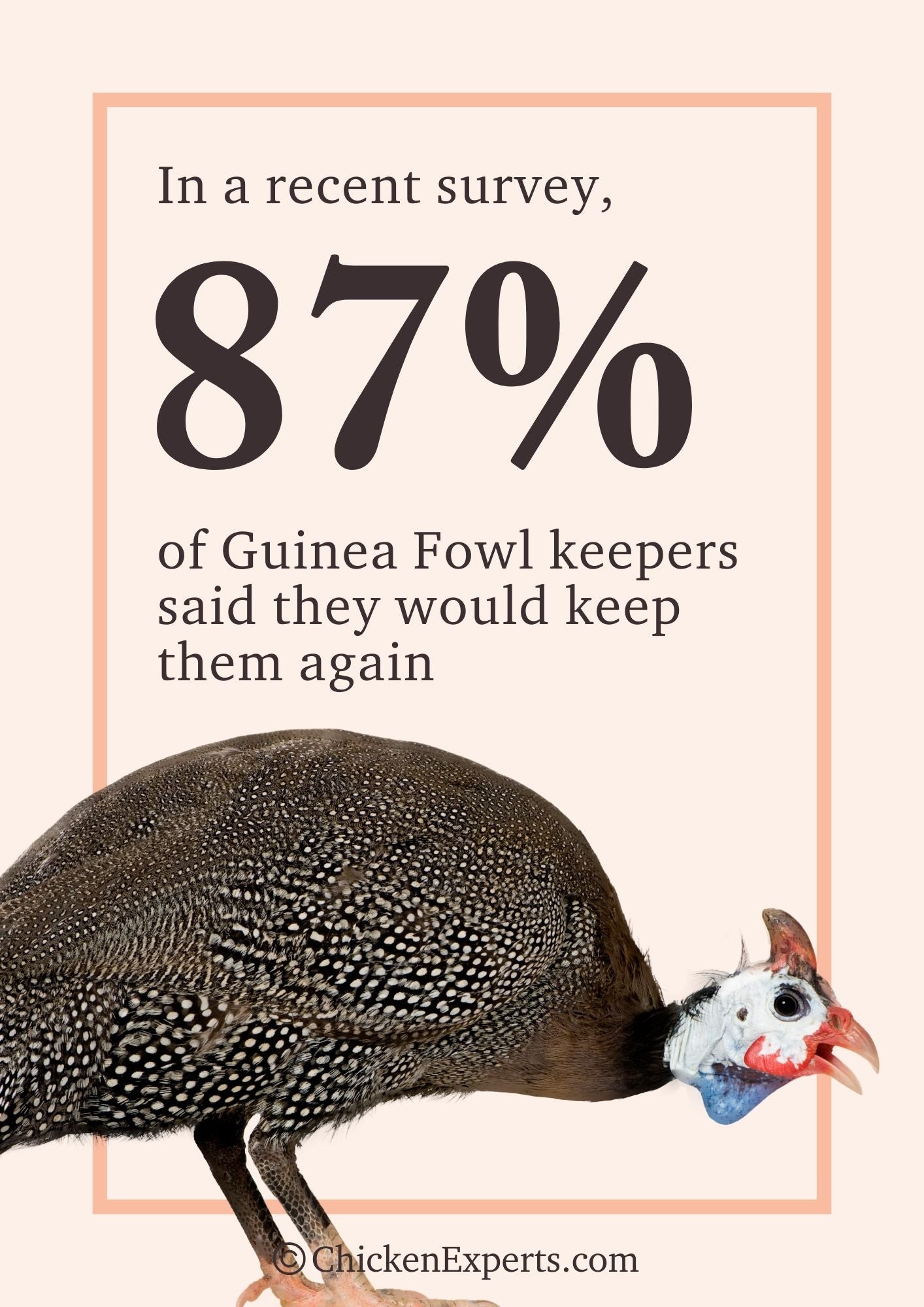
Just 20% say the only thing they find frustrating about keeping Guineas is how far they wonder (and sometimes never return).
I’ve covered everything you need to know when it comes to understanding and owning Guineas.
Ok, so without further ado, let’s get cracking:
- Do Guinea Fowl Make Good Pets?
- What Are Guinea Fowl Good For?
- Guinea Fowl as Pest Control
- How Many Eggs Do Guinea Fowl Lay?
- What Do Guinea Fowl Eggs Look Like?
- Are Guinea Fowl Eggs Tasty?
- What’s a Guinea Keet?
- Raising Guinea Fowl Keets
- Caring For Guinea Fowl
- What To Feed Guinea Fowl
- How Much Space Do Guinea Fowl Need?
- Are Guinea Fowl Hardy?
- Common Guinea Fowl Health Issues
- Are Guinea Fowl Like Chickens?
- What Do Guinea Fowl Look Like?
- How Big Are Guinea Fowl?
- Are Guinea Fowl Hens Broody?
- Do Guinea Fowl Mate for Life?
- What Varieties of Guinea Fowl Are There?
- Helmeted Guinea Fowl
- Crested Guinea Fowl
- Vulturine Guinea Fowl
- What Colors Do Guineas Come In?
- Pearl Grey Guinea Fowl
- Pied Guinea Fowl
- Royal Purple Guinea Fowl
- Blue Guinea Fowl
- Chocolate Guinea Fowl
- White Guinea Fowl
- Where Do Guinea Fowl Come From?
- Natural Habitat of Guinea Fowl
- The Pros & Cons of Keeping Guinea Fowl
- How Can I Tell a Male from a Female Guinea Fowl?
- Are Guinea Fowl Friendly?
- Guinea Fowl as Security
- Are Guinea Fowl Good for Meat?
- Where To Buy Guinea Fowl
MEET THE GUINEA FOWL

1. Do Guinea Fowl Make Good Pets?
Guinea Fowl aren’t kept for cuddles. They can become tolerant of human attention if they’re raised with regular interaction, but they’re not ‘petty’ pets. Guineas are there to do a job, and they’re happiest being left to work in their pack.
Guineas are best kept for function and funnies. They’re entertaining to watch!
2. What Are Guinea Fowl Good For?
Guinea Fowl have lots of uses, but the main reasons people pick these plucky personalities for their homesteads include pest control, flock and property security, eggs, meat, and entertainment!
3. Guinea Fowl as Pest Control
Pest control is one of the primary perks of keeping guineas. They will practically wipe out pesky pests like ticks, grasshoppers, spiders, caterpillars, slugs, and even scorpions and mice!
Sure, chickens and ducks can do this stuff, but guinea fowl are careful, considerate, and crop-friendly foragers. Unlike chickens, they won’t scratch up your veg patch or chomp on your petunias, and unlike ducks, they won’t trample your tomatoes.
4. How Many Eggs Do Guinea Fowl Lay?
Guinea fowl lay between 80 – 130 eggs a year. Guineas are seasonal layers, and each clutch will have 15-30 eggs. You’ll have to find them first though since guineas aren’t fans of nest boxes and prefer to nest hidden amongst nature’s undergrowth.
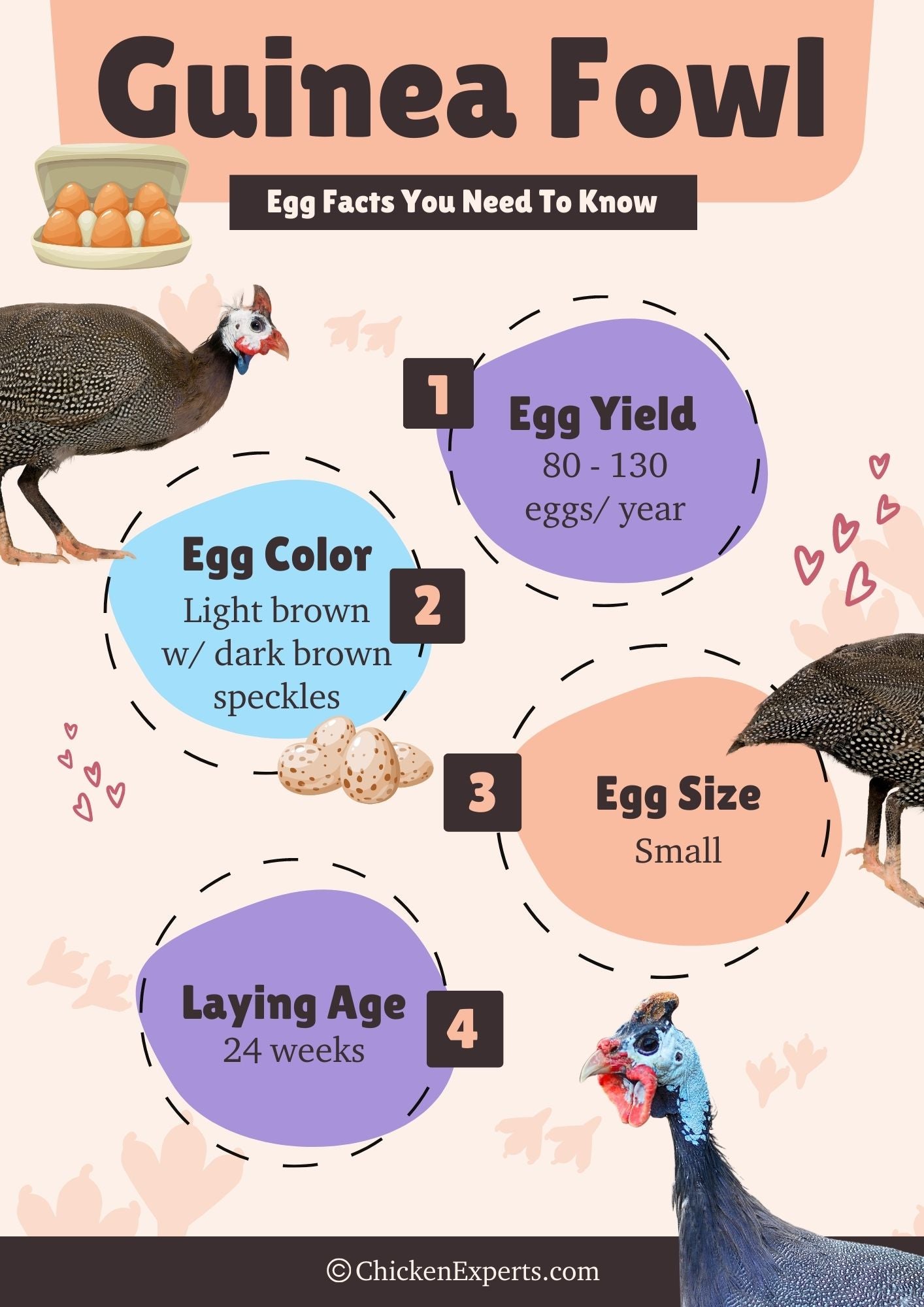
5. What Do Guinea Fowl Eggs Look Like?
Guinea fowl eggs are small and light brown with dark brown speckles. They look a lot like chicken eggs🥚 but are a bit less pointy.
6. Are Guinea Fowl Eggs Tasty?
Guinea fowl eggs are rich and tasty with yummy orange yolks. This is arguably more down to them preferring to be kept free range than genetics, but who cares, they taste great!
Guinea fowl eggs have a higher yolk to white ratio than chicken eggs, so are creamier, and great for baking.
7. What’s a Guinea Keet?
It’s a baby! Guinea fowl ‘chicks’ are known as keets.

8. Raising Guinea Fowl Keets
Since guinea hens often abandon their keets after they’ve hatched, raising baby guinea fowl is likely to become your job.
You can try your luck placing eggs under a broody chicken like a Silkie chicken, or you can incubate the eggs and raise them until they’re about 3-6 weeks old.
You’ll need to pick your moment to keet-nap them though. Mummy Guinea’s are aggressive!
You’ll need to brood keets at 95 to 100° for a week, keep them warm and dry and away from any draughts, and start them off in life with a pheasant or turkey starter feed at 28% to 30% protein. You can add a few tablespoons of sugar to a quart of warm water to give them quick, chill-free, energy.
Raising keets is otherwise very similar to raising baby chickens.
9. Caring For Guinea Fowl
Guinea Fowl are very self-sufficient characters– which is great – but if you fail to read up on their quirky ways before introducing them to your home, you are bound to fall fowl of a few Guinea bloopers! Here’s the basics of Guinea care to get your started…
10. What To Feed Guinea Fowl
Adult guinea fowl are so easy to feed. Just let them roam! Guineas are such effective foragers that they’ll sort their own dinner. Feeding your adult guinea fowl will cost you the same as the bugs in the ground– nothing!
11. How Much Space Do Guinea Fowl Need?
Guinea fowl shouldn’t be kept cooped up. It’s no good for them or your eardrums.
Guineas need acreage to roam, they won’t take to confined spaces or smaller yards or gardens.
If you can train them to return to the coop at night or to nest that’s great, but it’s best not to bank on it. Guineas will prefer trees and bushes to nest, but in a coop (or shed, they’re not fussed), make sure you give them a minimum of 3-4 square feet each, or you’ll spot their stress.
12. Are Guinea Fowl Hardy?
Guinea fowl are notoriously hardy and need very little care or interaction. Their bald heads help them handle the heat, and they can handle themselves free ranging in hot and cold climates, they just need a little shelter.
Hens do lay seasonally, so their laying season will last longer in warmer climates.
13. Common Guinea Fowl Health Issues
A healthy Guinea will live for 10-15 years since they’re hardy and can hold their own against predators.
Guinea fowl keets are vulnerable to dampness and cold for the first couple of weeks of their life, but after that, Guineas are very healthy hardy birds. As keets, splayed legs known as Spraddle leg can be an issue but it’s easily fixed if you know how.
Free-ranging means that the guinea’s diet is its worst enemy as well as its biggest perk.
Consuming a diet of bugs and beasts does put the guinea at risk of tummy bugs. Bacterial and gut illnesses can have rapid impacts on your guinea’s health, so make sure you know how to care for your guinea fowl before you bring these birds home.
14. Are Guinea Fowl Like Chickens?
You wouldn’t be the first to think guinea fowl are much like chickens, but they’re not. They’re not as domesticated or friendly as chickens and shouldn’t be your go-to plan for a backyard poultry pet
15. What Do Guinea Fowl Look Like?
Guinea fowl remind me of a miniature version of a cassowary: they’re beefy looking birds with funky facial tattoos. Guinea Fowl are large oval-bodied birds with rounded wings and short, curvy beaks. They look more like a turkey than any other bird.
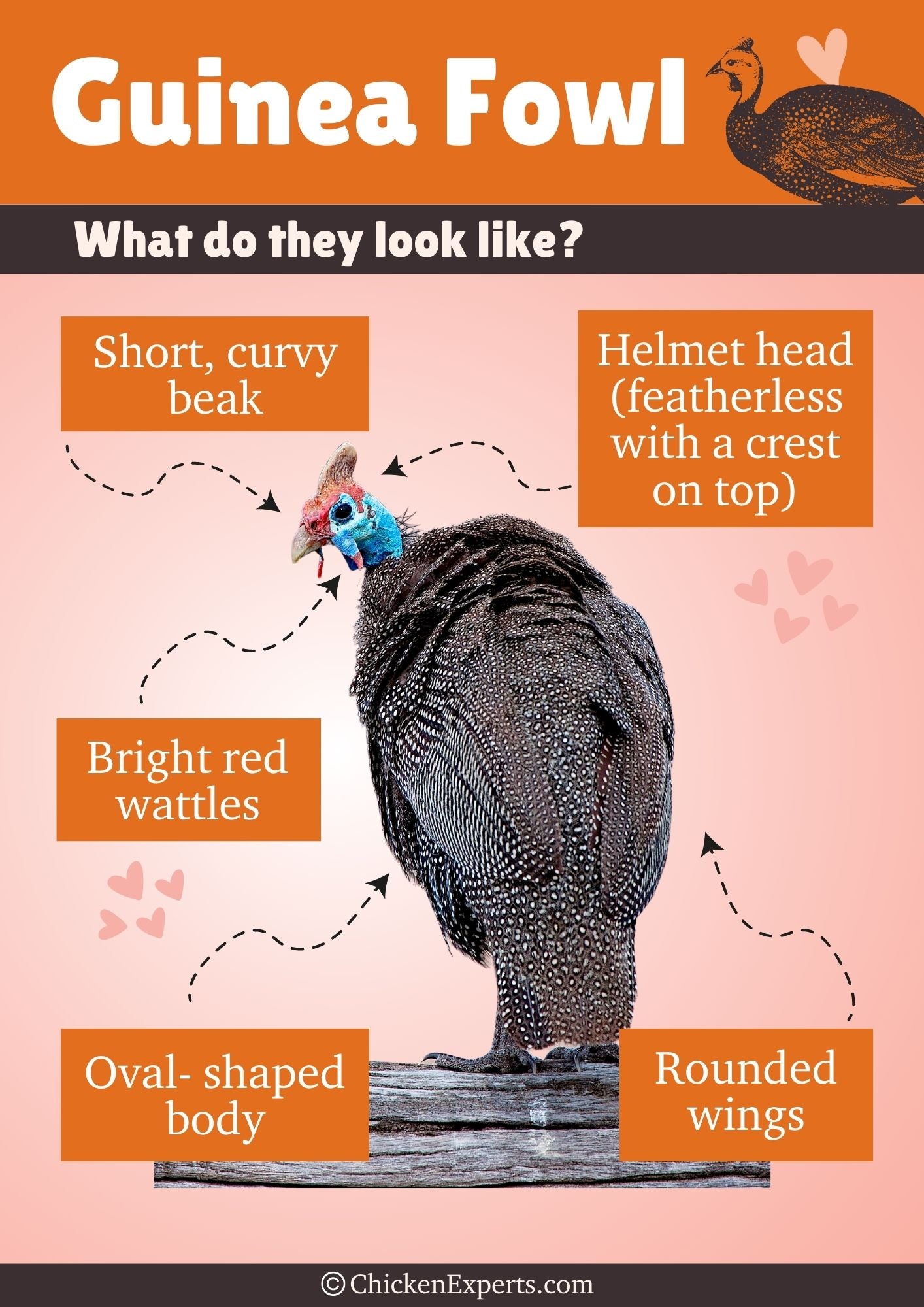
Sure, on paper they don’t sound so pretty but hear me out.
Guineas are stunning in their own, quirky way. They have such stunning plumage and lusciously long eyelashes. The most common coloration is pearl grey; an iridescent slatey-colored base with tiny white pearly-polka dots.
They really are pretty, even with their helmet heads. With over 20 different colors to pick from, there will be a guinea out there that takes your fancy!
16. How Big Are Guinea Fowl?
Guinea fowl stand at 53 – 58 cm tall, measure 40 – 71 cm in length, and weigh anything from 1.3 to 1.6 kilos when they’re fully grown. They have a massive 6-foot wingspan which is great for shooing away unwanted visitors!😊
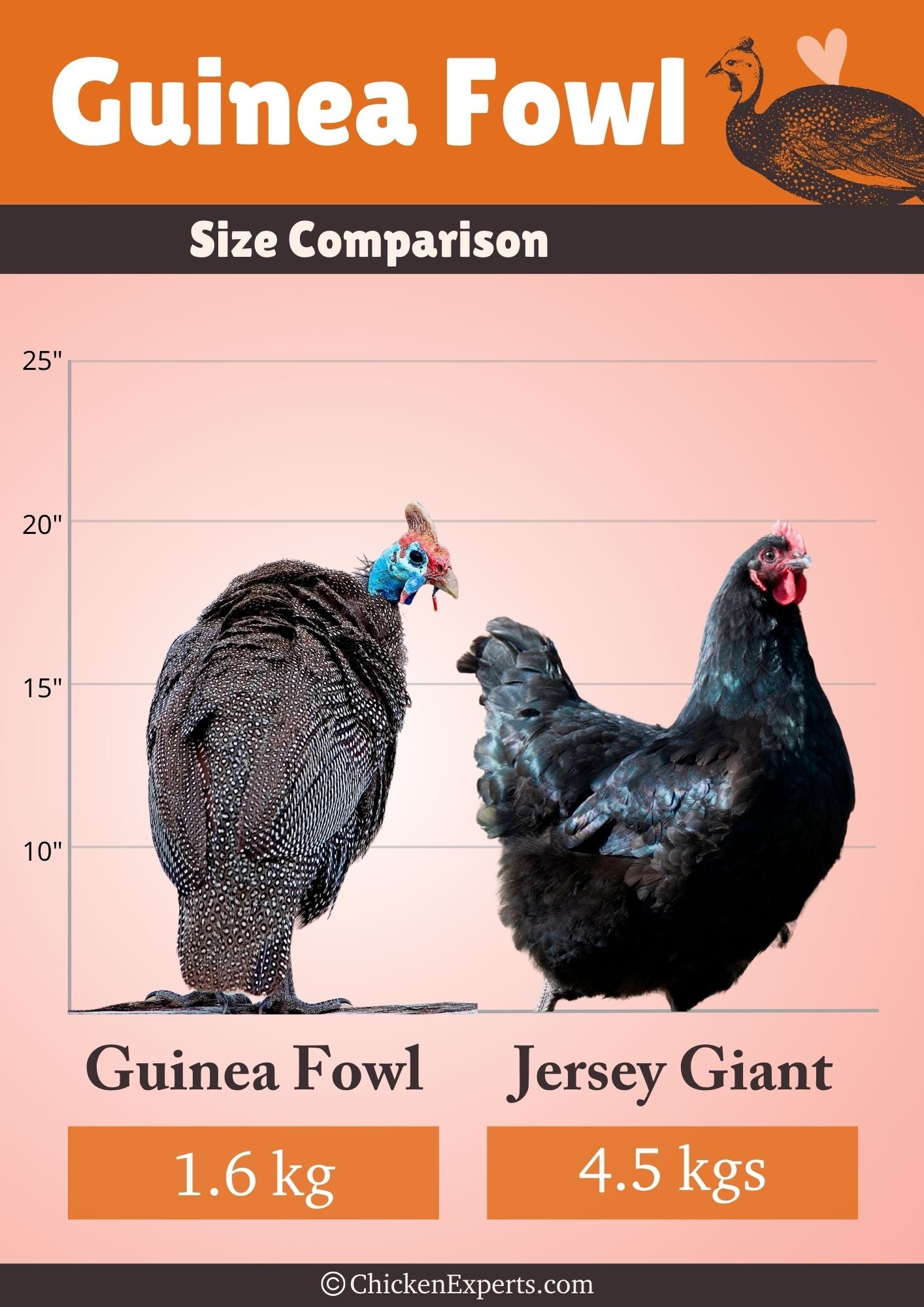
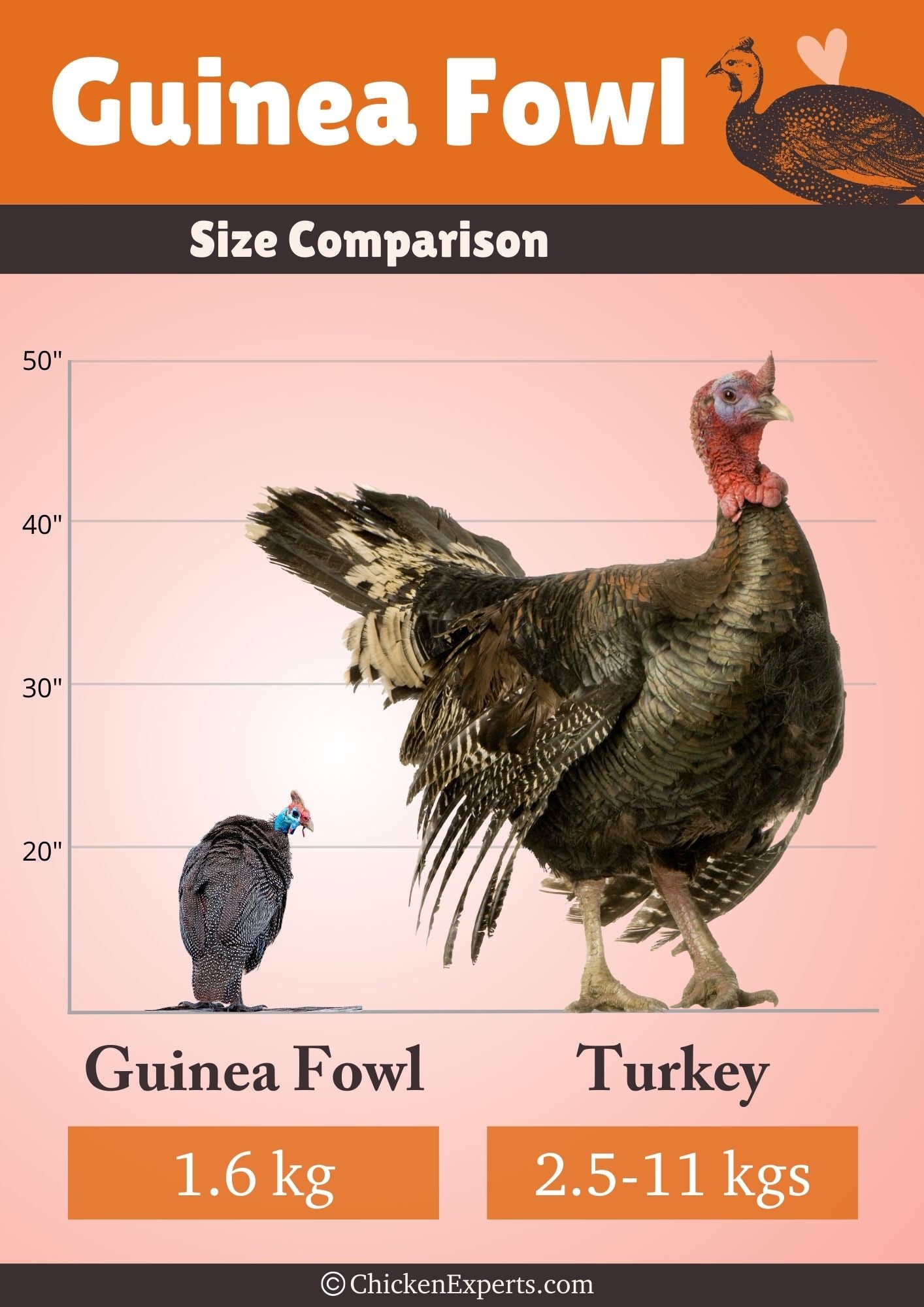
Guinea fowl look and act more like turkeys or pheasants, but size-wise they’re smaller than turkeys and larger than your average chicken.
17. Are Guinea Fowl Hens Broody?
Guinea fowl hens make great sitters, but not they’re not the most cautious of mamas. If you don’t find those eggs – wherever she’s laid them this time – you’ll likely have a clutch of keets in a month which you’ll need to care for if you want to get them through their first two weeks of life.
Guinea hens are seasonal layers, and they tend to nest on the ground amongst bushes and leaves. They’ll diligently sit on clutches of up to 20 eggs for the 26-28 days it takes them to hatch. Daddy will patrol too, keeping Mummy and babies safe from unwanted visitors…including you.
Once those cute little keets hatch, Mum’s done her bit! She’ll probably run off exploring straight away and keets that follow her will suffer from injuries and the damp grass. This is where you come in, but guinea keets are so damn cute you won’t mind!
18. Do Guinea Fowl Mate for Life?
Guinea Fowl will stick to one mate for life. It might sound romantic, but males will be sticking to 4-5 females. Make of that what you will.
19. What Varieties of Guinea Fowl Are There?
There are several species of wild Guinea fowl which are further categorized into four genera. Each species of Guinea has different habitat requirements and personalities, so it’s worth knowing your helmets from your plumes! There are also 20 different colors to pick from. Which Guinea will you go for?
In the US, it’s all about the helmeted guinea, but the crested guinea is also known for its attitude! Other species include the vulnerable white-breasted and the rare-plumed guineas which are sadly suffering due to the loss of their natural habitats in West Africa.
The 3 Most Common Species of Guinea Fowl
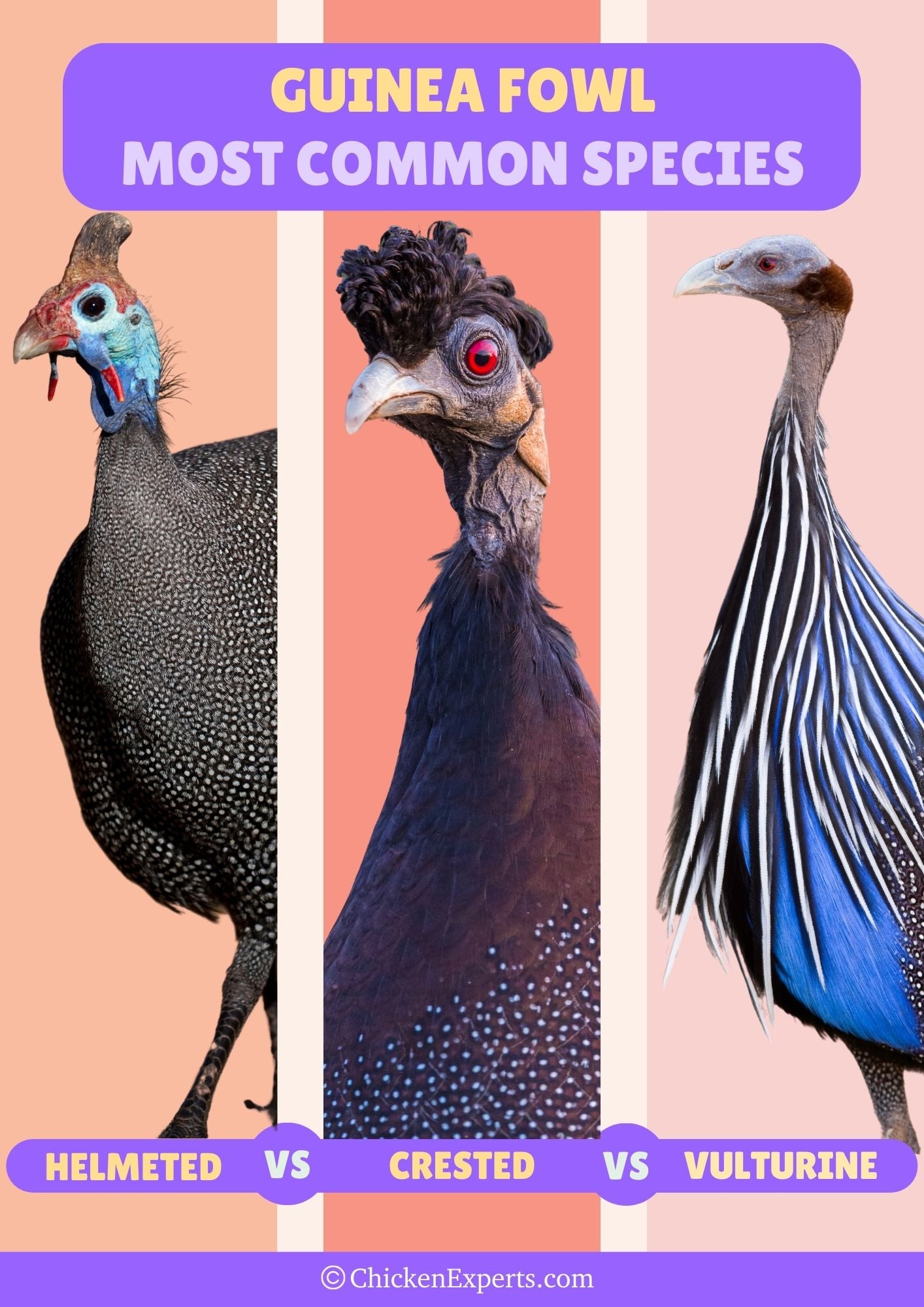
Helmeted Guinea Fowl
The helmeted guinea fowl is the most common domesticated guinea in the US. You can’t miss them with their characteristic bony lumps on their heads which look like – you’ve guessed it – helmets.
Crested Guinea Fowl
Crested guinea fowl are the angriest birds of the guinea pack! If you have a fox problem, perhaps the crested variety is the guinea for you. Those curly mops may look cute, but crested guineas are notoriously violent.
Vulturine Guinea Fowl
The vulturine is the big baby of the guinea fowl. It’s the biggest in size, but has the softest, tamest temperament. It’s also a bit of a wimp and needs to be kept in larger groups to feel safe.
20. What Colors Do Guinea Fowl Come In?
Guinea Colors and patterns aren’t as distinct as chickens. You’ll see all sorts of gorgeous one-off combinations which makes every Guinea seem special.
If you’re interested in picking the perfect shade of feather for your flock appeal then you can swot up on the genealogy of guinea fowl colors here.
In the US, only the Helmeted Guinea Fowl is formally acknowledged in either pearl, white, or lavender. They are just a tiny sample of the colors available to enjoy if you’re not bothered about showing them.
Guineas are all a mix of blue, grey, brown, and white, but in true poultry fashion, these mixes have descriptive names:
- Pearl Gray
- White Pied (or splash)
- Porcelain
- Opaline
- Slate
- Brown
- Light Lavender
- Lavender
- Royal Purple
- Coral Blue
- Buff Dundotte
- Buff
- Powder Blue
- Sky Blue
- Chocolate
- Violet
- Bronze
- Pewter
- Blonde
The 6 Most Popular Colors of Guinea Fowl
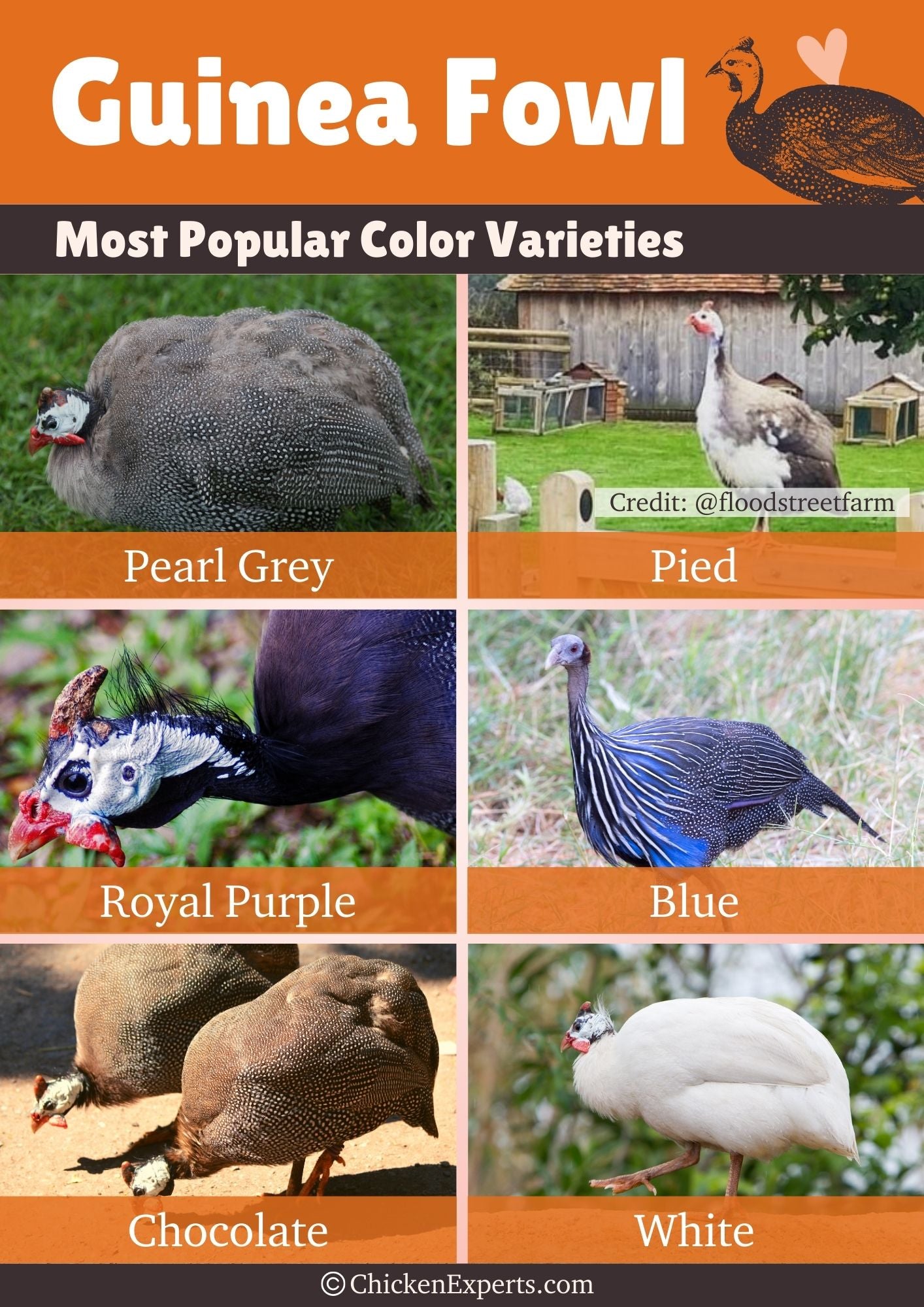
Pearl Grey Guinea Fowl
Sometimes known as the pearl guinea, this is the traditional uniform for guinea fowl. Dark grey with gorgeous tiny pearly-white polka dots. The pearl-grey Guinea has three black stripes separated by narrow orange stripes on its head. Very distinctive indeed! The beaks, legs, and feet are peachy orange.
Pied Guinea Fowl
Pied guinea fowl always have white chests, wings, and sometimes backs, but are otherwise a mix of purple, chocolate, blue, and pearl.
Royal Purple Guinea Fowl
Royal purple guinea fowl deserve a mention because they are soooo pretty! They have a slate grey/black background with an iridescent purple sheen and their wing feathers are very lightly spotted with white.
Blue Guinea Fowl
The most popular blue guinea fowl variants are the coral blue which is pale, powdery-blue with gradients of dark blue around the edges of their feather and some spots. You can also get sky blue and solid blue amongst lots of other beautiful blue birds.
Chocolate Guinea Fowl
Chocolate guinea fowl are dark brown with a few dots and bars on their wings. As keets, their feathers are milky brown, but as they grow, they show their true colors.
White Guinea Fowl
The white guinea fowl rock a pure white look, though, like most blondes, you can spot some black roots if you look closely at the nape of their neck. Their meat is also lighter in color.
21. Where Do Guinea Fowl Come From?
Guinea Fowl are native to the Guinea coast of Africa, hence their name. They found their way to Europe in the late 15th century, most likely as a meat source, and as they grew in popularity, they were introduced to lots of other lucky countries including Australia and North America.
22. The Natural Habitat of Guinea Fowl
Different species of Guinea Fowl favor different habitats which range from hot tropical forests and damp marshy grasslands to deserts. They’re hardy birds and adapt well to most environments.
23. The Pros & Cons of Keeping Guinea Fowl
So, are guineas what you’re after or not? Let’s sum up the plus points and the pitfalls of these poultry Pitbulls.
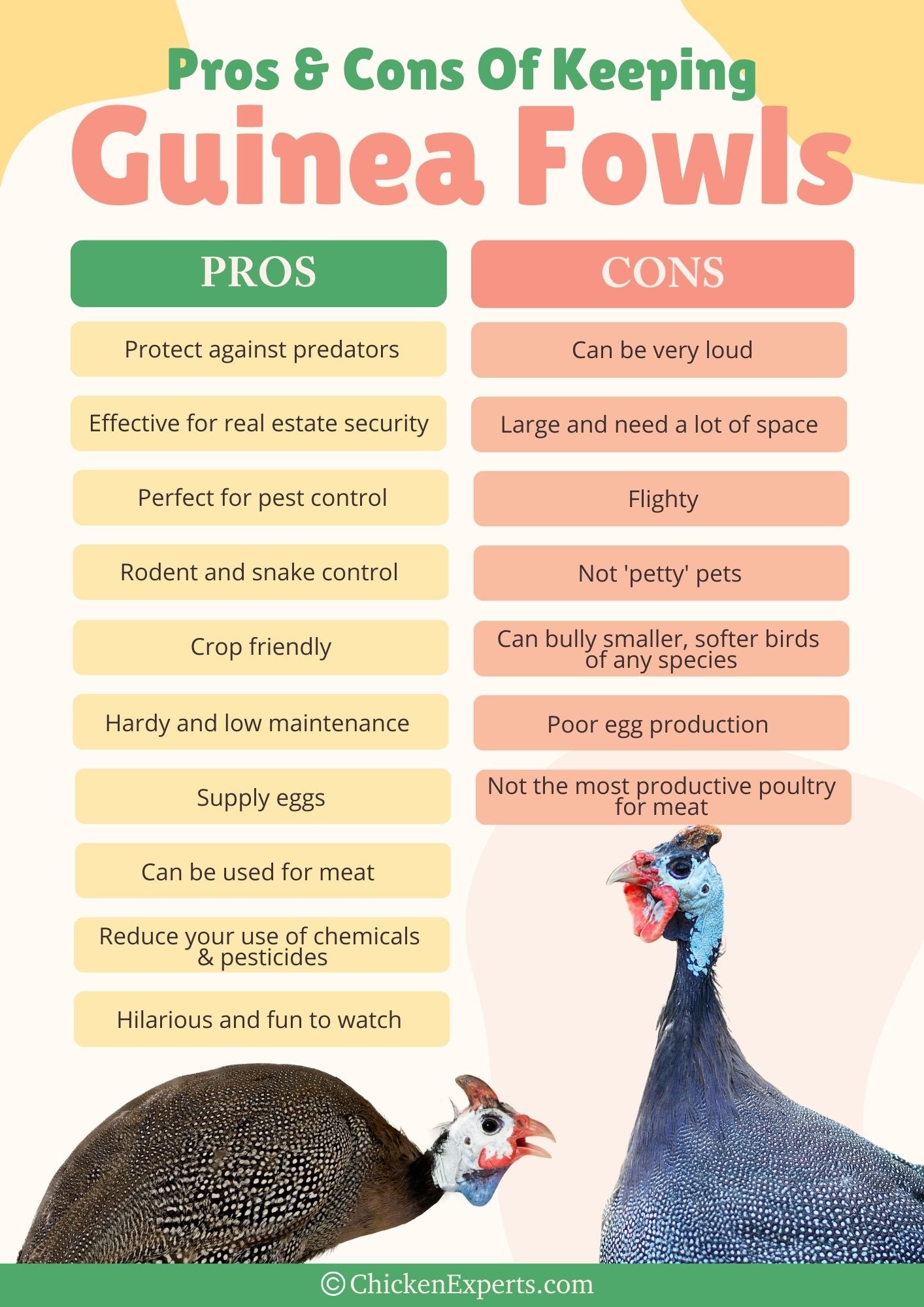
10 Reasons to Keep Guinea Fowl
- Guineas are egg-septional predator protection for flocks
- Guineas are effective for real estate security
- Guineas are perfect for pest control including ticks
- Guineas are even good for rodent and snake control
- Guineas are crop friendly – they won’t trash your veg patch!
- Guineas are hardy & low maintenance
- Guineas will supply eggs
- Guineas can be used for meat
- Guineas will reduce your use of chemicals and pesticides
- Guineas are hilarious. They’re just so funny to watch
10 Reasons Not to Keep Guinea Fowl
- Guineas are gobby. They’re loud
- Guineas are large and need a lot of space
- Guineas are not suited to confinement and are flighty
- Guineas are not ‘petty’ pets
- Guineas can bully smaller, softer birds of any species
- Guineas are not the top choice of poultry for egg production
- Guineas are not the most productive poultry for meat
- Guineas can be loud
- Guineas are often loud
- Guineas are very loud (I hope I’ve made this bit clear?)
24. How Can I Tell a Male from a Female Guinea Fowl?
Guinea fowl are notoriously hard to sex. As keets (baby guineas) you’ve got no chance!
The most dependable way to sex your guinea is by the sound of its call. Female guineas make ‘buckwheat, buckwheat, buckwheat’ noises which some people think sounds a little like ‘come back, come back' which may make it harder to leave for work in the morning! Male guineas sound very different and make a ‘chi, chi, chi’ noise.
As they grow, males tend to be a little larger than females, but females tend to weigh a little more than males. It’s those lovely curves. With mature guineas which do have wattles (they don’t all have them) the boys tend to have larger wattles. As Guineas don’t mature sexually until they’re 2 years old, you’ll be waiting a while to use either of these sexing methods.
25. Are Guinea Fowl Friendly?
Guinea Fowl aren’t people poultry. The Guinea Fowl temperament is edgy, alert, aggressive towards predators, and aloof, or mildly interested in familiar humans.
Guineas are pack animals. They like to be kept in a group, not alone, and will socialize – sometimes even mate - with chickens who can hold their own, but they can bully smaller, less aggressive birds.
26. Guinea Fowl as Security
Guinea fowl are popular as loud-mouthed, top-notch home security solutions. Whilst they’re generally quite chatty and trilly and this all happens at a considerately low level, they’ll alert to pretty much anything.
When they alert, they will scream! If there’s an issue and you will know about it. Predators, snakes, rats, cats on the prowl, a packet of crisps being opened, or any human visitors will be cause for a guinea alarm.
Guinea fowl owners make a valid point that an aggressive guard dog can get you prosecuted just by doing its job. There’s not the same risk with poultry alarms!
27. Are Guinea Fowl Good for Meat?
Guinea fowl meat is often considered a delicacy! They don’t taste as gamey as other fowl, and the meat is darker than chicken meat, richer in flavor, and lower in calories and fat.
Guineas need to be harvested young for meat, at between 12 and 20 weeks. Wait too long and the meat gets tough and chewy. Yuck.
28. Where To Buy Guinea Fowl
Since guinea fowl aren’t a popular choice in urban areas, it’s not that likely you’ll have anyone local selling guinea keets privately.
Here’s a brilliant resource from Guineas.com to help you find reputable Guinea breeders.
BEEN THERE, DONE THAT? ARE YOU A GUINEA FOWL GUINEA PIG?
SHARE YOUR GUINEA-SPERIENCE HERE….
Mixed species flocks are becoming more and more popular in homesteads, and why not since you get the pleasures and the privileges of lots of different poultry personalities and their eggs!
Mixed flocks need a lot of planning and prep though. Their unique dietary and housing needs can spell disaster if you haven’t done your homework.
Some chicken breeds can handle mixed-flock life easier than others, some species need different nest boxes whilst others will watch each other’s eggs whilst their fellow fowl pop out for a graze.
Chickenpedia is the perfect place to get your mixed flock questions answered, learn everything you need to know to get started and find all the expert facts, advice, tips, and hints to help you ace flock life.
You can even sit eggsams…which you will of course fly through!


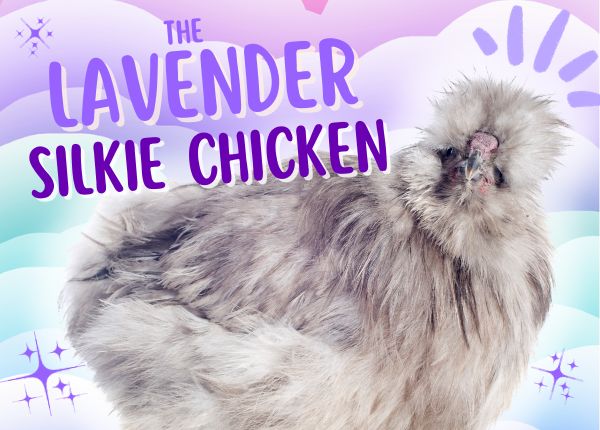
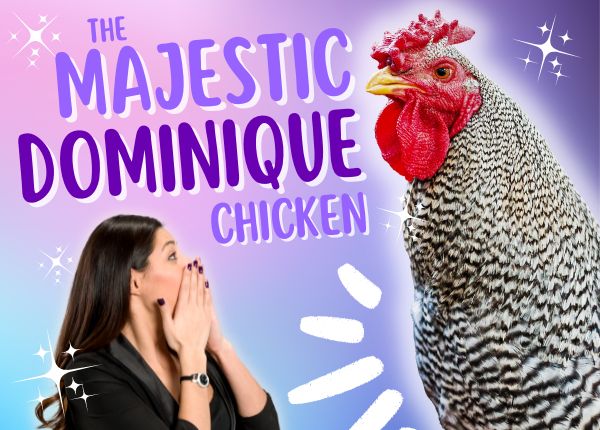



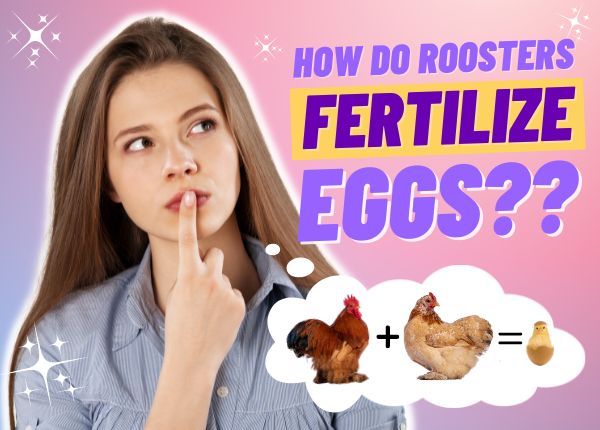



Leave a comment (all fields required)